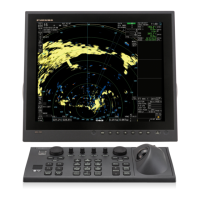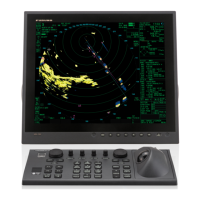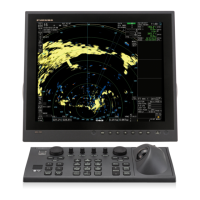
Do you have a question about the Furuno FAR-2238S-NXT-BB and is the answer not in the manual?
| Display Size | 12.1 inches |
|---|---|
| Antenna Type | Open Array |
| Magnetron | Yes |
| AIS Display | Yes |
| Antenna Rotation Speed | 24/48 rpm |
| Range | 0.125 to 48 nautical miles |
| Antenna Length | 1.8 m (6 ft) or 2.4 m (8 ft) |
| Target Tracking | Up to 100 targets |
| Radar Type | Solid State |
| Power Supply | 24 VDC |
| Operating Temperature | -25°C to +55°C |
Provides general information on manual usage, copyright, and equipment modification policies.
Instructions for proper disposal of the product and used batteries according to local regulations.
Explains the meaning of safety symbols and hazard levels used in the manual for user protection.
Clarifies the types of safety actions required or prohibited for safe equipment operation.
Provides an overview of the radar control unit, detailing buttons and functions for operation.
Explains the procedure for powering the radar system on and off using the control unit.
Details how to adjust screen and echo brilliance using the control unit or on-screen menus.
Describes the three main areas of the radar system's on-screen display and their functions.
Covers how to open, close, and navigate through the radar system's menus and submenus.
Explains how to access radar functions via on-screen boxes as menu shortcuts.
Guides on activating cursor-related functions directly from the guidance box or CURSOR menu.
Explains how the cursor data display shows latitude/longitude or X-Y coordinates.
Details how to assign specific radar functions to the F1 to F4 keys for one-touch access.
Covers customizing various operation items like mouse wheel direction and key beep volume.
Explains how to select the source for the ship's heading input, such as gyrocompass.
Details how to input own ship's speed via automatic sources or manual entry.
Explains how to select the data source for the own ship's position, such as EPFS or ECDIS.
Describes how to adjust the local time and switch between UTC and LOCAL time formats.
Covers resetting and saving/loading user-defined radar settings to default or custom profiles.
Explains how to switch the radar between transmit (TX) and standby (STBY) modes.
Details the automatic and manual tuning procedures for magnetron radars.
Explains how to select appropriate pulselengths for different range scales and function keys.
Covers adjusting the receiver sensitivity using the GAIN control for optimal radar performance.
Explains methods for reducing sea clutter using A/C SEA control, manually or automatically.
Details how to reduce rain clutter using AUTO RAIN and A/C RAIN controls.
Explains how to activate the interference rejector to suppress signals from other radars.
Describes how to enlarge targets to make them easier to see, with three available types.
Explains how the echo averaging feature reduces sea clutter and enhances target discrimination.
Covers the ACE function for automatic detection and reduction of sea and rain clutter.
Details how to reduce white noise to improve the on-screen S/N ratio.
Explains how the wiper feature reduces brilliance of weak signals for clearer picture.
Describes how to assign function keys to provide optimum radar settings for specific navigation needs.
Explains how to enable or disable the rejection of false echoes that appear at incorrect ranges.
Describes the available orientation modes like Head Up, Course Up, and North Up for radar display.
Explains how to select the radar range scale and range ring interval for optimal target observation.
Details methods for measuring target range using fixed rings, cursor, or VRM.
Explains methods for measuring target bearing using EBL keys or on-screen menu operations.
Describes how to use offset EBL for measuring range/bearing between targets and assessing collision risk.
Guides on measuring range and bearing between two targets using EBL and VRM.
Explains how to displace the sweep origin to expand the view field without changing the range scale.
Covers displaying target trails as synthetic afterglow to show target movement history.
Describes how the target analyzer function analyzes echoes to help determine dangerous targets.
Explains how to set alarm zones for targets entering specific areas with audiovisual alerts.
Details how PI lines are used for keeping a constant distance from coastlines or partner ships.
Explains how to use the net cursor to depict fishing net location on the radar display.
Describes how to enlarge an area of interest for closer examination, with magnification options.
Covers using various marks like heading line, stern mark, north mark, and barge marker.
Explains how to inscribe a drop mark at a selected location to find range and bearing from own ship.
Details how to select and customize brilliance and color schemes (palettes) for on-screen data.
Covers displaying and setting up navigational data like depth, wind, and water temperature.
Explains how to set up the information box to display target data, navigational data, and zoomed areas.
Describes the interswitch function for transferring video and control signals between antennas and displays.
Explains how to activate and check the radar's performance using the performance monitor.
Details how to change the reference position for measurements and markers (ANT or CCRP).
Covers the anchor watch feature that alerts when the ship drifts beyond a set threshold.
Explains alert priority, category, and interpretation of alert messages and icons.
Details how to rotate the antenna without transmission to prevent freezing.
Covers selecting display modes like CIRCLE, WIDE, and ALL for B/W-type radars.
Explains how to format, handle, and manage data on SD cards for marks, settings, and logs.
Details how to use the built-in screenshot feature to save the current display.
Describes the watch alert feature that provides visual reminders at regular intervals.
Explains how to display images from two radars simultaneously on one display.
Covers outputting echo data to a PC with wave analysis software for indication of wave data.
Explains the Doppler feature for clutter reduction and target identification.
Provides general information about radar observation, including minimum and maximum range.
Explains common false echoes like multiple echoes, sidelobe echoes, and virtual images.
Details the SART description, how it works, and how to show SART marks on the radar display.
Describes RACON as a radar beacon that emits signals and appears as a rectangular echo.
Explains how the RTE improves target detection by amplifying and re-transmitting radar signals.
Discusses solid-state radar characteristics, range, signal intensity, and false echoes.
Outlines critical warnings and cautions for safe and accurate use of target tracking features.
Details the primary keys used for target tracking operations on the control unit.
Explains how to show/hide TT symbols and provides an overview of the TT modes and settings.
Guides on selecting TT acquisition modes (manual, automatic, or combined) for target acquisition.
Covers acquiring and tracking targets, including manual acquisition and automatic target acquisition.
Explains methods for inputting own ship's speed using echo-referenced data or manual entry.
Details procedures for canceling target tracking for individual targets or all tracked targets.
Describes the TT lost alert system, how to set the lost target filter, and enable/disable lost alerts.
Covers adjusting TT symbol brilliance, color, and selecting TT symbols for B/W-type radars.
Explains how to display and remove target data (range, bearing, course, speed) in the data display area.
Guides on activating and setting preset names for TT targets, displayed alongside TT numbers.
Details vector modes (relative/true) and stabilization options for displaying target movement.
Explains how the past position display shows target trails and how to select the number of points.
Covers manual entry of water current direction (set) and speed (drift) for accurate vector calculations.
Details how the radar calculates CPA and TCPA, and how to set ranges for collision alarm.
Explains the function of acquisition zones for alerting targets and automatic acquisition.
Covers simulating own ship's movement against tracked targets to assess maneuver safety.
Lists the main reasons for TT alerts, including collision, acquisition zone, lost targets, and target capacity.
Explains how to simulate collision risk for crew familiarization and training purposes.
Details the criteria for target acquisition and tracking, including quantization and echo analysis.
Discusses factors like sea returns, rain clutter, low clouds, and radar interference that can affect target tracking accuracy.
Details the primary keys used for AIS operations, including Target Data and Target Cancel functions.
Provides an overview of the AIS box, its indications, and their respective meanings for display settings.
Explains how to select display modes like DISP OFF, DISP FILT, and DISP ALL for AIS symbols.
Describes the meaning of various AIS symbols that indicate object status on the display.
Covers filtering out unnecessary AIS objects to reduce screen clutter using the AIS DISP FILTER menu.
Details how to convert sleeping AIS targets to activated targets for better movement visualization.
Explains how to "sleep" activated AIS targets to focus on important radar and AIS targets.
Guides on inputting voyage data such as navigational status, ETA, and destination for AIS.
Covers displaying basic and expanded AIS data for selected objects, including pop-up information.
Details how to adjust AIS symbol brilliance, size, and color for better visibility.
Explains the past position display for activated AIS targets and how to select plotting intervals.
Describes the AIS lost alert system, including how to set the AIS lost filter.
Covers setting the lower limit of ROT (Rate Of Turn) for AIS symbol heading indication.
Details how the radar calculates CPA and TCPA for AIS targets and sets alarm ranges.
Explains how to associate TT and AIS targets to present a single symbol for the same physical target.
Covers viewing own ship's static data, such as type, call sign, and dimensions.
Details how to create, save, transmit, view, and delete AIS messages.
Lists AIS system messages, their priority, and meanings displayed on the screen.
Describes six available orientation modes for the radar display, including True Motion.
Guides on selecting different types of markers for radar maps, such as origin marks and waypoints.
Details how to select the location for marker inscription, such as cursor position or own ship.
Explains how to create and display radar maps using lines and symbols, referencing WGS-84 datum.
Covers how to mark prominent targets or points of interest and set their stabilization (fixed or moving).
Details how to adjust ten locations on the own ship mark to depict its shape more realistically.
Explains how to display marks received from an ECDIS, including user charts and route information.
Covers showing/hiding tracks for own ship and targets, and setting the plotting interval and track color.
Details how to set data sources, enter, erase, and display waypoints, including route management.
Explains how to set/edit internal routes, display routes, and skip waypoints for navigation.
Covers showing/hiding charts, aligning chart position, selecting chart types, and chart settings.
Provides a schedule for regular maintenance checks and measures for optimal performance and longevity.
Details the location of fuses for AC and DC powered configurations and the procedure for replacement.
Shows the estimated life expectancy for consumable parts like magnetrons and motors.
Provides instructions for cleaning the trackball and retaining ring to resolve cursor movement issues.
Offers troubleshooting procedures for common problems like picture freeze, no display, or incorrect settings.
Describes hardware and software troubleshooting procedures for qualified service personnel.
Explains how to execute a diagnostic test program to check major circuit boards and components.
Details how to check input sentences for the radar and save sentence information or screenshots.
Explains how the equipment automatically uses secondary sensors when the primary fails, and function limitations.
Lists and explains general radar symbols like power, own ship, heading, and stern lines.
Displays radar map symbols specific to B/W radar types, including marks, lines, and prohibited areas.
Displays radar map symbols specific to IMO/A/R radar types, including buoys, danger highlights, and coastline.
Explains the various TT symbols representing acquired targets, dangerous targets, and lost targets.
Describes AIS symbols indicating activated, sleeping, dangerous, and lost targets, including ship shapes.
Explains AIS AtoN symbols for racons, cardinal marks, hand marks, and safe water.
Shows the internal parts layout of the RCU-014 control unit, including PCBs and buzzer.
Illustrates the internal parts of the RCU-015/RCU-016 control units, highlighting trackball and key board.
Details the internal components of the Processor Unit RPU-025, including boards, fans, and fuses.
Shows the internal parts of the RSB-128 scanner unit, including RF Unit and De-icer board.
Illustrates the internal components of the RTR-105/106 RF Unit, such as RF TB board and MMIC board.
Shows the internal parts of the RSB-146 scanner unit, including motor and RF Unit.
Details the internal components of the RTR-131/132 RF Unit, such as MD board and IF-SPU board.
Illustrates the internal parts of the RSB-129 scanner unit, including RF Unit and motor.
Shows the internal components of the RTR-107 RF Unit, such as MIC board and SPU board.
Details the internal parts of the RSB-130 scanner unit, including motor and RF TB board.
Illustrates the internal components of the RTR-108 RF Unit, such as magnetron and RF PWR board.
Shows the internal parts of the RSB-131 scanner unit, including RF Unit and motor.
Details the internal components of the RTR-109 RF Unit, such as magnetron and IF board.
Illustrates the internal parts of the RSB-133 scanner unit, including RF Unit and performance monitor.
Shows the internal components of the RTR-111 RF Unit, such as HPA board and RF-CONV board.
Details antenna radiator type, beam width, and sidelobe attenuation for X-band and S-band.
Provides TX frequency, modulation, output power, and range scale details for the transceiver.
Lists minimum range, range discrimination, accuracy, bearing discrimination, and warm-up time.
Details screen type, brightness, visible distance, and effective diameter for monitor units.
Covers the number and types of ports for processor unit, LAN, and data sentences.
Specifies power supply requirements for processor, monitor, HUB, and de-icer units.
Outlines ambient temperature, relative humidity, and degree of protection for the equipment.
Lists the unit color codes for antenna, processor, transceiver, monitor, and radar console.
Details frequency range, input/output power, and step level for performance monitors (PM-32A/B, PM-52A/B).











